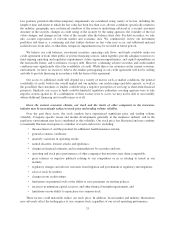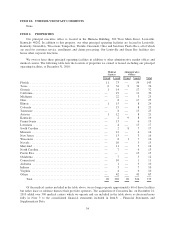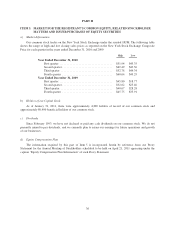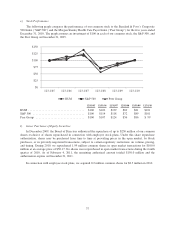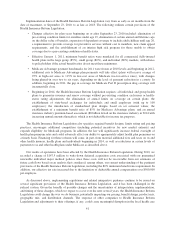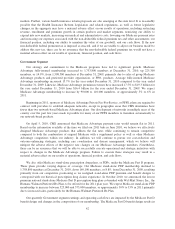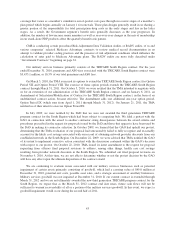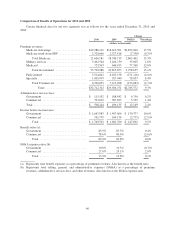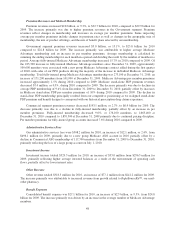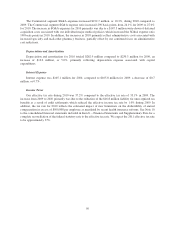Humana 2010 Annual Report Download - page 53
Download and view the complete annual report
Please find page 53 of the 2010 Humana annual report below. You can navigate through the pages in the report by either clicking on the pages listed below, or by using the keyword search tool below to find specific information within the annual report.coverage that varies as a member’s cumulative out-of-pocket costs pass through successive stages of a member’s
plan period which begins annually on January 1 for renewals. These plan designs generally result in us sharing a
greater portion of the responsibility for total prescription drug costs in the early stages and less in the latter
stages. As a result, the Government segment’s benefit ratio generally decreases as the year progresses. In
addition, the number of low-income senior members as well as year-over-year changes in the mix of membership
in our stand-alone PDP products affect the quarterly benefit ratio pattern.
CMS is conducting certain procedural Risk-Adjustment Data Validation Audits, or RADV audits, of us and
various companies’ selected Medicare Advantage contracts to review medical record documentation in an
attempt to validate provider coding practices and the presence of risk adjustment conditions which influence the
calculation of rates paid to Medicare Advantage plans. The RADV audits are more fully described under
“Government Contracts” beginning on page 61.
Our military services business primarily consists of the TRICARE South Region contract. For the year
ended December 31, 2010, premiums and ASO fees associated with the TRICARE South Region contract were
$3,435.1 million, or 10.3% of our total premiums and ASO fees.
On March 3, 2010, the TMA exercised its options to extend the TRICARE South Region contract for Option
Period VII and Option Period VIII. The exercise of these option periods extends the TRICARE South Region
contract through March 31, 2011. On October 5, 2010, we were notified that the TMA intended to negotiate with
us for an extension of our administration of the TRICARE South Region contract, and on January 6, 2011, an
Amendment of Solicitation/Modification of Contract to the TRICARE South Region contract, in the form of an
undefinitized contract action, became effective. The Amendment adds one additional one-year option period,
Option Period IX (which runs from April 1, 2011 through March 31, 2012). On January 21, 2011, the TMA
notified us of their intent to exercise Option Period IX.
In July 2009, we were notified by the DoD that we were not awarded the third generation TRICARE
program contract for the South Region which had been subject to competing bids. We filed a protest with the
GAO in connection with the award to another contractor citing discrepancies between the award criteria and
procedures prescribed in the request for proposals issued by the DoD and those that appear to have been used by
the DoD in making its contractor selection. In October 2009, we learned that the GAO had upheld our protest,
determining that the TMA evaluation of our proposal had unreasonably failed to fully recognize and reasonably
account for the likely cost savings associated with our record of obtaining network provider discounts from our
established network in the South Region. On December 22, 2009, we were advised that TMA notified the GAO
of its intent to implement corrective action consistent with the discussion contained within the GAO’s decision
with respect to our protest. On October 22, 2010, TMA issued its latest amendment to the request for proposal
requesting from offerors final proposal revisions to address, among other things, health care cost savings
resulting from provider network discounts in the South Region. We submitted our final proposal revisions on
November 9, 2010. At this time, we are not able to determine whether or not the protest decision by the GAO
will have any effect upon the ultimate disposition of the contract award.
We are continuing to evaluate issues associated with our military services businesses such as potential
impairment of certain assets primarily consisting of goodwill, which had a carrying value of $49.8 million at
December 31, 2010, potential exit costs, possible asset sales, and a strategic assessment of ancillary businesses.
Military services goodwill was not impaired at December 31, 2010. If our current contract is extended through
March 31, 2012 and we are not ultimately awarded the new third generation TRICARE program contract for the
South Region, we expect that as the March 31, 2012 contract end date nears, future cash flows will not be
sufficient to warrant recoverability of all or a portion of the military services goodwill. In this event, we expect a
goodwill impairment would occur during the second half of 2011.
43


